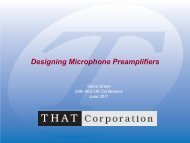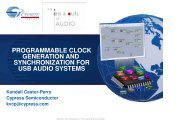The Ins and Outs of Audio
The Ins and Outs of Audio
The Ins and Outs of Audio
You also want an ePaper? Increase the reach of your titles
YUMPU automatically turns print PDFs into web optimized ePapers that Google loves.
Introduction<br />
• <strong>The</strong>re once was a time when the word “audio”<br />
referred only to pressure variations in air<br />
– For most people, sounds heard as musical tones have a frequency<br />
range <strong>of</strong> about 32 Hz to 8 kHz (-3 to +5 octaves from middle C)<br />
– Sounds outside <strong>of</strong> this range can also be heard, but not necessarily<br />
as musical tones (e.g. thunder, breaking glass, drums, cymbals)<br />
• Perhaps the very earliest form <strong>of</strong> audio “processing”<br />
consisted <strong>of</strong> acoustic wave shaping dating back to the<br />
Greeks in the 4 th century BC<br />
– A small megaphone was sometimes built into player masks<br />
– Amphitheater design (e.g. see Epidaurus on the Peloponnese)<br />
– <strong>The</strong> “<strong>Ins</strong>” <strong>and</strong> “<strong>Outs</strong>” were simply the acoustic signal itself
Early <strong>Audio</strong> Recordings<br />
• Fast forward to 1857--the first known audio recording<br />
is made by Édouard-Léon Scott, a Parisian inventor<br />
– <strong>The</strong> “phonautograph” converted acoustic sound energy into lines<br />
scratched on soot-darkened paper<br />
– Record-only! (Playback finally happens in 2008)<br />
• <strong>The</strong> first practical audio recording <strong>and</strong> reproduction<br />
device was invented by Thomas Edison in 1877<br />
– <strong>The</strong> “phonograph” converted acoustic sound energy via a horn<br />
<strong>and</strong> stylus into grooves scratched on a rotating cylinder<br />
– Playback was the inverse process<br />
– Quickly became a huge commercial success--millions <strong>of</strong> units<br />
were sold <strong>and</strong> used around the world by 1900
<strong>The</strong> Analog Disc…a Big Development<br />
• Soon after Edison’s cylinder system, Emile Berliner<br />
invented the gramophone disc in 1887<br />
• Discs were cheaper to mass produce than cylinders<br />
– <strong>The</strong>y overtook cylinder sales around 1910 (Edison responded by<br />
creating his own “Edison Disc Record” company)<br />
– “78” rpm became the st<strong>and</strong>ard due to synchronous ac motors<br />
• 78.261 rpm = (60 Hz)*60*(1/46); 77.922 rpm = (50 Hz)*60*(2/77)<br />
• 0.43% pitch difference (≈7.4 “cents” or 0.074 <strong>of</strong> a semi-tone)<br />
– <strong>The</strong> “45” <strong>and</strong> “33 1/3 LP” vinyl disc formats followed after WW2<br />
• <strong>The</strong> analog disc remained a viable audio technology<br />
for almost 100 years!
Everything Became More Interesting<br />
with the Advent <strong>of</strong> Electrical Signals<br />
• <strong>The</strong> instantaneous sound pressure level is represented<br />
by a continuous voltage (or current) waveform<br />
– Inherently AC coupled -- i.e. absolute atmospheric pressure is not<br />
normally represented by a DC component in the analog signal<br />
• <strong>The</strong> inventions <strong>of</strong> the vacuum tube, microphone, <strong>and</strong><br />
loudspeaker pr<strong>of</strong>oundly changed audio<br />
– <strong>The</strong> microphone <strong>and</strong> loudspeaker replaced clumsy horn-to-stylus<br />
mechanisms even though disc storage prevailed into the 1980s<br />
– Countless refinements <strong>and</strong> new circuit techniques led to dramatic<br />
improvements in audio quality<br />
– New forms <strong>of</strong> audio signal storage were also developed based on<br />
magnetic wires <strong>and</strong> tape
But Most Important, Electrical Signals<br />
can be Easily <strong>and</strong> Intentionally Altered<br />
• Gain <strong>and</strong> Frequency Response<br />
– Volume control (think about it!)<br />
– Tone controls, scratch filters<br />
– Equalization (pre-emphasis) for lower noise in recordings<br />
• RIAA for discs, NAB for tapes (<strong>and</strong> later NR systems)<br />
• Mixing <strong>of</strong> multiple inputs<br />
– Recording <strong>of</strong> large ensembles, full orchestras became practical<br />
– Added reverberation<br />
• “Intentionally Altered” later takes on a whole new<br />
meaning with compressed digital audio…
So What Can Go Wrong With Analog?<br />
• Just about everything!<br />
– Amplitude scaling, impedance mismatch<br />
– Absolute phase or polarity<br />
– Frequency <strong>and</strong> phase response errors<br />
– Non-linear distortion (THD, IMD, DIM, etc.)<br />
– Noise<br />
– Crosstalk from other audio signals<br />
– Power supply hum<br />
– Demodulation <strong>of</strong> radio/TV signals<br />
– Frequency shifts/modulation from mechanical storage/playback<br />
– Frequency modulation from Doppler effects within loudspeakers<br />
– Ground loop interference
Source <strong>and</strong> Load Impedances<br />
• 600Ω was a de-facto st<strong>and</strong>ard for many years<br />
– Equal source <strong>and</strong> load impedance maximizes power transfer<br />
which was particularly important in field <strong>of</strong> telephony<br />
– Reference signal levels were specified in terms <strong>of</strong> the “dBm” unit<br />
(0 dBm = 1 mW, or 0.7746 Vac into 600Ω) even though the meters<br />
actually read voltage <strong>and</strong> not power<br />
– Mismatched impedances caused all manner <strong>of</strong> grief<br />
• Over the years audio equipment has moved towards a<br />
much lower source Z <strong>and</strong> a much higher input Z<br />
– Maximizes voltage transfer<br />
– Allows several inputs to be paralleled or “bridged” without a<br />
significant loss in signal level<br />
– <strong>The</strong> “dBu” unit begins to displace dBm in the 1980s
Measurement <strong>of</strong> <strong>Audio</strong> Signal Level<br />
• Early metering technology permitted only average<br />
detection, rms-calibrated voltage measurements<br />
– OK for setting levels with relatively pure test tones, but not very<br />
accurate for measuring noise or distortion<br />
– True rms detection was not very practical before the mid 1970s<br />
• However even true rms detection does not accurately<br />
display the apparent level <strong>of</strong> audio program material<br />
– <strong>The</strong> “VU” meter (1939) was an attempt to normalize results <strong>and</strong><br />
still remains in use today<br />
– Thus evolved the “peak program meter” (PPM) using peak or<br />
quasi-peak detection schemes<br />
– But even today, PPM st<strong>and</strong>ards vary significantly by country; both<br />
in terms <strong>of</strong> defining the meter response <strong>and</strong> the displayed scale
Absolute Polarity<br />
• <strong>The</strong> idea is that a positively increasing pressure wave<br />
at the microphone should ultimately be reproduced as<br />
a positively increasing pressure at the loudspeaker<br />
– Requires st<strong>and</strong>ardization <strong>of</strong> polarity throughout the entire audio<br />
path including processing equipment, transducers, <strong>and</strong> connectors<br />
– <strong>The</strong> infamous XLR pin-2/pin-3 issue in the 1980s<br />
• Typically measured using an asymmetric waveform in<br />
the time domain <strong>of</strong>ten consisting <strong>of</strong> a pure tone plus<br />
about 50% <strong>of</strong> its 2 nd harmonic<br />
– However polarity is much more difficult to measure acoustically<br />
except at low frequencies<br />
– Phase vs. frequency or group delay vs. frequency measurements<br />
using the log chirp sweep technique is far more reliable
Frequency & Phase Response Errors<br />
• Equalization errors with analog storage media<br />
– For example: RIAA for discs <strong>and</strong> NAB for tapes<br />
• Loudspeakers are still somewhat enigmatic due to<br />
directionality, mechanical resonances, cone breakup,<br />
<strong>and</strong> driver compression effects<br />
– <strong>The</strong> weakest link in the entire audio chain<br />
• Subtle response differences between the outputs in a<br />
multi-channel system can cause poor “imaging”<br />
– Difficulty in localizing specific instruments or voices<br />
– Objective measurements remain illusive…so far<br />
– Likely to become even more important with “3D” audio
Noise<br />
• “<strong>The</strong>rmal” noise: V N<br />
= (4*k*T*R*BW) 0.5<br />
• “Shot” noise: I N<br />
= (2*q*I dc<br />
*BW) 0.5<br />
• “1/f” <strong>and</strong> “Popcorn” noise in semiconductors<br />
– Mechanisms still not well understood, but under control<br />
• “Modulation” noise in resistors<br />
– Signal dependent<br />
– Caused by component material imperfections usually resulting in<br />
AM noise sideb<strong>and</strong>s surrounding a pure tone<br />
– Carbon composition types can be terrible, thick-film is generally<br />
OK, thin-film is better, wire or metal foil is the best
Distortion<br />
• Harmonic distortion <strong>of</strong> a pure tone is relatively easy to<br />
underst<strong>and</strong> via a Taylor series model <strong>of</strong> non-linearity<br />
– “THD” versus “THD+N”<br />
– Completely fails to yield usable information in a b<strong>and</strong>width limited<br />
system if the fundamental is above ≈1/3 <strong>of</strong> the upper limit<br />
• Inter-Modulation Distortion (IMD) is caused by the<br />
non-linear interaction <strong>of</strong> two or more signals<br />
– “SMPTE” (e.g. 50-60 Hz + 7 kHz, mixed 4:1), originally devised<br />
to test the exposure level <strong>of</strong> optical sound tracks on cinema film<br />
– “DFD” (e.g. 14 kHz + 15 kHz, 1:1), useful for characterizing the<br />
non-linearity near the top edge <strong>of</strong> a b<strong>and</strong>width limited system<br />
– “DIM” (e.g. 3.15 kHz square-wave + 15 kHz sine-wave), useful<br />
for characterizing slew-rate dependent non-linearity
Ground Loops…a Very Nasty Reality<br />
• We live in a world full <strong>of</strong> stray magnetic fields<br />
– Power transformers, fluorescent light ballasts, fans, motors<br />
– Magnetic deflection interference from old CRT monitors<br />
– Improperly wired AC Mains outlets (neutral-ground shorts)<br />
• <strong>The</strong> interconnection <strong>of</strong> two <strong>of</strong> more pieces <strong>of</strong> audio<br />
equipment will create ground loops (via the safety<br />
ground <strong>and</strong>/or other audio connections) into which<br />
unwanted AC potentials will be induced<br />
– Unbalanced analog circuits cannot distinguish between ground<br />
loop induced potentials <strong>and</strong> the desired audio signal<br />
– Practical solutions usually involve transformer coupling to “float”<br />
or isolate the source or the input from ground
Balanced Circuits to the Rescue<br />
• <strong>The</strong> Balanced Analog Circuit<br />
– Comprises two signal conductors, neither <strong>of</strong> which is intentionally<br />
connected to the common or chassis (a grounded third conductor<br />
is <strong>of</strong>ten used to provide electrostatic shielding in a balanced<br />
cable)<br />
• <strong>The</strong> impedance from each conductor to ground must<br />
be equal in a balanced system<br />
– Both source <strong>and</strong> load must abide by this rule<br />
– Transformer coupling can cause a slight mismatch in stray<br />
shunting capacitance due to winding length/turn differences<br />
– Note that conductor voltage symmetry is NOT a requirement!<br />
• Balanced inputs must be designed to respond only to<br />
the differential voltage between the two conductors
Digital <strong>Audio</strong> – a Paradigm Shift<br />
• A/D <strong>and</strong> D/A technology reached a critical threshold<br />
in the early 1980s with the development <strong>of</strong> 14-16 bit<br />
converters that were fast enough for audio signals<br />
– Lesser resolution converters were also used along with analog<br />
compression-expansion schemes to increase the dynamic range<br />
– Dithering overcame initial concerns there would be a total loss <strong>of</strong><br />
audio below the quantization level <strong>of</strong> the least significant bit<br />
• In 1982, the invention <strong>and</strong> availability <strong>of</strong> the “CD” or<br />
compact disc forever changed public expectations<br />
– Most people could hear a dramatic improvement in audio quality<br />
when comparing the new CDs to equivalent vinyl disc recordings<br />
– CDs did not wear out, scratch, <strong>and</strong> could be played in automobiles<br />
<strong>and</strong> portable battery-power units
So What Can Go Wrong With Digital?<br />
• Not too much assuming:<br />
– Nearly ideal A/D <strong>and</strong> D/A conversion<br />
– Clean (low jitter) clocks<br />
– Bit error rates (BER) <strong>of</strong> zero in digital transmission <strong>and</strong> storage<br />
– Absolute mathematical precision in any digital signal processing<br />
• However, it’s the assumptions that can go wrong<br />
– A/D <strong>and</strong> D/A conversion is not ideal<br />
– Clocks are not perfectly clean, difficulty in recovering a clock<br />
– Bit errors in digital signal transmission <strong>and</strong> storage (usually not a<br />
problem with modern error correction schemes)<br />
– Digital signal processing is not perfect, or the use <strong>of</strong> codecs in<br />
low-bit rate systems
New Technologies New Problems!<br />
• Digital audio spawned a whole new family <strong>of</strong> issues<br />
– Clock jitter: How to measure, <strong>and</strong> how much is too much<br />
– Out-<strong>of</strong>-b<strong>and</strong> energy: Sigma-delta converters create large amounts<br />
<strong>of</strong> unwanted energy just above the audio b<strong>and</strong>. 3-pole b<strong>and</strong>width<br />
limiting filters that were once adequate for testing analog systems<br />
needed to become much sharper “brick-wall” filters<br />
• Lossy digital protocols inherently distort the audio<br />
signal, but hopefully in ways that are mostly inaudible<br />
– <strong>The</strong> concept <strong>of</strong> masking<br />
– “Adequate <strong>Audio</strong>” or “How low can the bit rate really be?”<br />
• Class-D amplifiers can introduce significant distortion<br />
from the passive LC filter in the output stage
Example #1: HF DAC Behavior<br />
• <strong>The</strong> next series <strong>of</strong> slides show the typical spectra <strong>of</strong> a<br />
highly regarded audio DAC after it has been<br />
processed through a 5-pole analog low-pass filter (F -3<br />
≈112 kHz)<br />
– Note the increase in noise floor above 20 kHz due to shaping from<br />
the sigma-delta conversion process<br />
– Also note the increasing magnitude <strong>of</strong> sideb<strong>and</strong>s related to sample<br />
rate harmonics as the signal frequency increases<br />
• <strong>The</strong> first <strong>and</strong> last slides in this series show the spectra<br />
<strong>of</strong> a very good analog sine oscillator for comparison<br />
– Today’s best audio DAC performance above 20 kHz still has a<br />
LONG way to go (perhaps 30-40 dB) to equal the performance <strong>of</strong><br />
analog test signal generators designed in the mid 1980s
Analog Sine Oscillator, F = 1 kHz
DAC Output, F = 1 kHz
DAC Output, F = 1 kHz, Linear Scale
DAC Output, F = 20 kHz
DAC Output, F = 78 kHz
DAC Output, F = 80 kHz
Analog Sine Oscillator, F = 80 kHz<br />
• New point<br />
– New comment<br />
– New comment<br />
• New point<br />
– New comment<br />
– New comment<br />
• Sub comment<br />
• Sub comment<br />
– New comment
Example #2: Bluetooth<br />
• In its best audio pr<strong>of</strong>ile (called “A2DP”), Bluetooth<br />
currently uses two codecs for audio data transmission<br />
– <strong>The</strong> “SBC” codec is the default selection<br />
– <strong>The</strong> “apt-X” codec must be licensed by the device manufacturer<br />
<strong>and</strong> may not be available in some Bluetooth products<br />
• <strong>The</strong> next slide shows typical spectra <strong>of</strong> a 1 kHz audio<br />
test signal near full scale (running at 44.1 kS)<br />
– Note the spurious content with the SBC codec versus the higher<br />
noise floor but “cleaner” characteristic <strong>of</strong> the apt-X codec<br />
– Disclaimer: <strong>The</strong>se results should not be interpreted as a definitive<br />
comparison, or as an indication <strong>of</strong> which codec sounds better.<br />
However, it would appear that current Bluetooth performance is<br />
not yet adequate for the most serious listening applications
Example #3: Class-D Amplification<br />
• Really strains the definition <strong>of</strong> “analog” audio<br />
– <strong>The</strong> technology inherently introduces unwanted artifacts into the<br />
analog output that are above the audio b<strong>and</strong><br />
– Typical switching frequencies are in the range <strong>of</strong> 200-750kHz,<br />
however harmonics can easily extend out beyond 200 MHz due to<br />
the small switching times necessary for good efficiency<br />
• <strong>The</strong> output LC filter is a potentially significant source<br />
<strong>of</strong> distortion within the audio b<strong>and</strong><br />
– <strong>The</strong> LC filter is necessary to comply with regulatory st<strong>and</strong>ards<br />
– <strong>The</strong> inductor values typically require the use <strong>of</strong> iron containing<br />
core materials which are inherently non-linear<br />
– Some more recent design topologies place the LC filter within the<br />
overall feedback loop in an attempt to reduce this distortion
Observations <strong>and</strong> Predictions<br />
• Analog interfaces will become less <strong>and</strong> less important<br />
in future audio equipment, especially consumer gear<br />
– However, let us never forget that “audio” is a very analog thing in<br />
the final analysis, i.e. pressure variations in the air<br />
– A/D <strong>and</strong> D/A conversion is moving into transducers: microphones<br />
with digital outputs, powered speakers with digital inputs<br />
• Non-copper forms <strong>of</strong> interconnection will most likely<br />
displace traditional hardware cables<br />
– Eliminates ground loops <strong>and</strong> digital common mode noise<br />
– Optical I/O is already here, supporting 192 kS rates<br />
– Bluetooth is in its relative infancy, still has a long way to go in<br />
providing high quality audio performance
Some More Observations<br />
• Digital audio protocols will continue to evolve<br />
– AES-EBU <strong>and</strong> SPDIF have been highly successful<br />
– HDMI-ARC (audio return channel) just becoming available<br />
– PDM <strong>and</strong> SLIMbus are potentially emerging<br />
• Another key trend is that audio <strong>and</strong> video data streams<br />
are merging into mixed protocols<br />
– Examples include SDI <strong>and</strong> HDMI<br />
• However there does seem to be an over-abundance <strong>of</strong><br />
old <strong>and</strong> new protocols…can all <strong>of</strong> them survive?<br />
– Some proposals are supported by only a few commercial entities<br />
– “Perfection is the evil <strong>of</strong> good”
In Conclusion<br />
• During my 41-year career in the design <strong>of</strong> test <strong>and</strong><br />
measurement instruments I have been privileged to<br />
witness <strong>and</strong> experiment with many new developments<br />
in the world <strong>of</strong> audio, sometimes long before they<br />
became publically available<br />
• One thing is certain: the future promises to bring new<br />
problems <strong>and</strong> challenges as audio technologies evolve,<br />
mature, <strong>and</strong> are replaced by even newer ones<br />
• During this seminar, “<strong>The</strong> <strong>Ins</strong> <strong>and</strong> <strong>Outs</strong> <strong>of</strong> <strong>Audio</strong>”, we<br />
shall explore some <strong>of</strong> these issues…now, let’s get on<br />
with the program!






